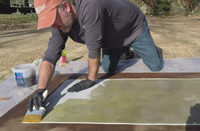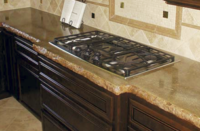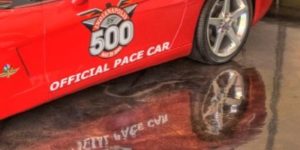
Acrylic stains offer an alternative to trickier acid etches, but the most unique decorative concrete designs created with water-based stains may come when the two methods are used in concert.
Acrylic stains can be used to create accents or glazing effects like faux marble or stone. When contractor and instructor Bob Harris was in Italy this year, he took inspiration from some of the historic Venetian floors, which he recreated with the color-upon-color process that is a large part of his business. This layering is possible only with water-based stains, Harris says.
Many applicators like to work with acrylic stains simply to avoid using acid stains, which generally give off more odor, require more cleanup, and provide less margin for error. Another factor on the plus side for acrylics is color selection, according to many contractors and dealers, including Doug Bannister, owner of The Stamp Store in Oklahoma City, which produces a line called SS Rainbow Stain System. When acid staining, color selection is limited by the concrete canvas you have to work with, Bannister says.
The color section of water-based stain helps ensure that concrete will remain a top choice of designers. Like most water-based stains, Rainbow can be used to enhance or even rescue acid colors that didn’t turn out as planned. Colors can be modified, intensified or diluted by adding more or less pigment to the base.
Another attractive feature of these stains is cost. They generally cost less to buy and apply than acid stains. The cost, combined with simple application methods and a forgiving nature, make acrylics a popular alternative to acid staining. Experts in acrylics say this is all true. But if you are looking to cut corners, don’t do it on prep, sealing or maintenance. “You almost need to be an extremist when it comes to preparation,” Harris says.
Like any topical coating, stains require a properly profiled concrete surface. If the surface isn’t mechanically and chemically ready to receive, the coating is likely to fail, says Chuck Brunner of Smith Paint Products.
Acrylic stains come in two basic categories. One penetrates the pores and bonds, the other fastens to the surface. Both require porosity to do their work. The first consideration is to know exactly what profile the product requires. “That’s paramount,” says Harris, who uses a variety of acrylic stains.
 Sources for this article said that most products require an International Concrete Repair Institute concrete surface profile of one or two. Getting there is the tricky part. To take a surface down to this relatively shallow profile, muriatic acid usually comes to mind. However, those with the most experience advise those with less to steer clear, or at least be aware that it’s harder than it looks.
Sources for this article said that most products require an International Concrete Repair Institute concrete surface profile of one or two. Getting there is the tricky part. To take a surface down to this relatively shallow profile, muriatic acid usually comes to mind. However, those with the most experience advise those with less to steer clear, or at least be aware that it’s harder than it looks.
Brunner says he does not recommend muriatic acid etching by anyone with less than 10 years experience. The reason is that it is prone to backfire. First, there is the mess and odor and hazardous materials regulations, all of which are compounded in interior settings. Second, he says, he often sees inexperienced contractors fail to neutralize the acid properly. Any leftover acid builds chalk on the surface of the concrete, which forces the topical stain to fail, costing the contractor a lot of money.
For interior surfaces, Brunner recommends simply using citric acid mixed with water. The white powder is available through food suppliers. He says this nontoxic acid has the power to etch the profile, but can be washed down drains. Harris recommends a more traditional approach with muriatic acid, but agrees that even experienced contractors have been known to fail. His process is pressure wash, rotary scrub, wet down, sprinkle with acid, rotary scrub again, pressure wash again, neutralize with ammonia bath, and finally, rinse. An alternative on interiors is a dustless grinding machine, which is not readily available to most contractors. Shot blasting is not recommended for this profile.
For exterior work, Brunner has another common-sense approach. He advises contractors to start the project by first hiring someone to clean the driveway, specifically someone with a 10-gallon-per-minute machine, a zero-degree rotating tip, and the ability to run hot water. This ensures a good cleaning as the first step before profiling.
Once the surface is prepped, water-based stains can be applied in a number of ways. When staining over acid stain, Harris often uses a pump sprayer. However, airless and compressor sprayers, rollers and brushes can be used, depending on the desired effect.
Inferiorities to acid staining that are less debatable come into play after water-based stains are applied. They are topical, they leave membrane that is exposed to traffic and wear, and the color coat has to be sealed.

Barbara Sargent of Kemiko Concrete Products Inc., which distributes the Rembrandt line of acrylic-urethane polymer stains, says these types of stains should be thought of as an equal part of a three-part product, and each third must be of good quality. The first part is the properly profiled surface, the second is the stain and the third is the sealer.
For a topcoat, acrylic urethane, polyurethane, or epoxies are commonly used. Some stains cannot take a solvent-based sealer, Harris warned, so as usual, be sure to know the manufacturer’s recommendations.
For high-traffic areas, Sargent recommends a sacrificial layer. Like others in the industry, she recommends that contractors sell the installation with an annual maintenance contract, or at least make sure that the customer is well-informed on how to maintain the piece.
Harris agrees. He advises colleagues to either sell a maintenance contract with the installation or teach the client how to do an annual deep scrub, rinse and reseal on exterior surfaces, and on top of that, how to wax interior floors each year.















